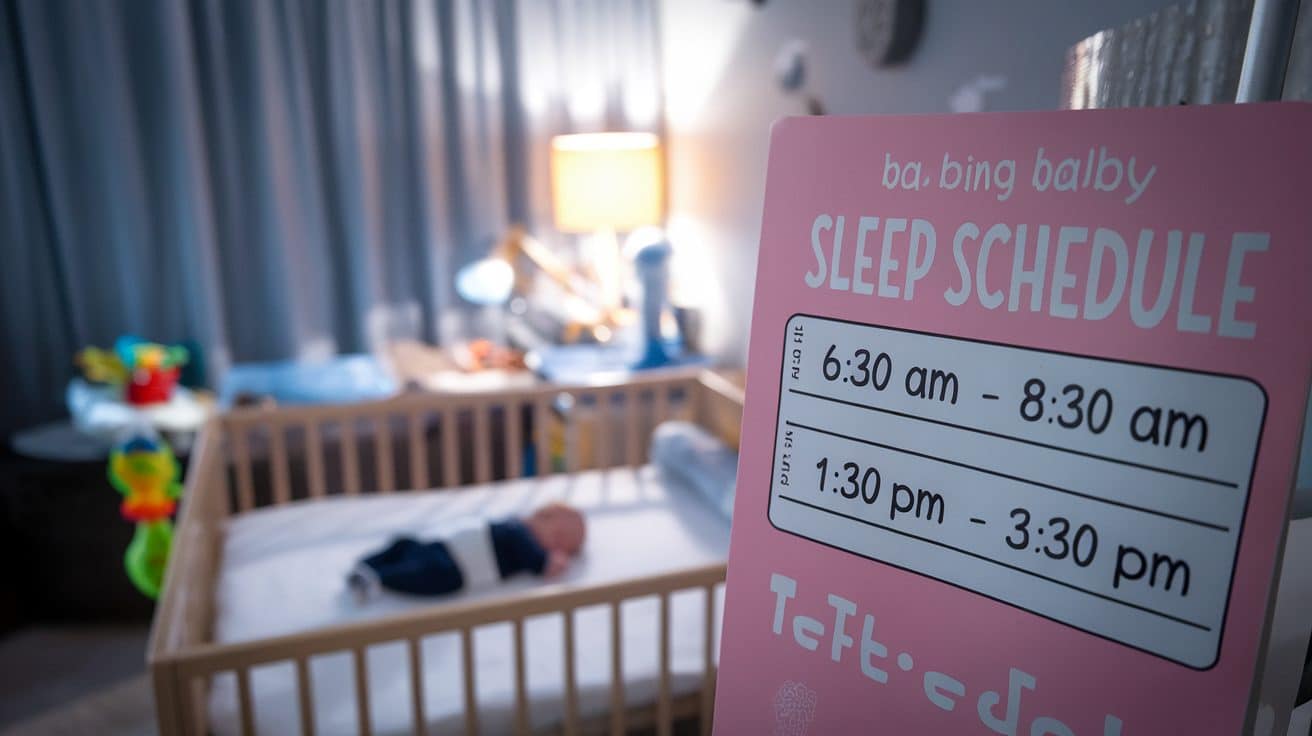When your baby drops to 2 naps, it might feel like solving a puzzle. One day, they’re happy with 3 naps; the next, they fight and sleep like tiny warriors.
Sounds familiar?
Most babies move to 2 naps between 6 and 9 months old. But here’s the thing – every baby writes their own sleep story.
If you’re wondering why your baby’s sleep schedule seems off, take a deep breath. We’ll walk through this together.
Let’s look at the signs that show your baby is ready for this big change. And don’t worry – you’re doing better than you think.
When Do Babies Drop to 2 Naps?
Most babies switch to 2 naps between 6.5 and 8 months old.
But your baby might have other plans. Some babies drop their third nap as early as 6 months. Others hold onto it until 9 months.
Think of it like your baby’s timeline, not a strict rule.
- Watch for your baby’s signals, not the calendar.
- Each baby moves at their own pace.
- Early or late transitions are both normal.
Remember, this is a gradual change, not an overnight switch.
Signs Your Baby Is Ready for 2 Naps

Your baby’s way of saying “I’m ready” isn’t with words. It’s with their sleep patterns.
Watch for these clear signs:
- Your little one fights that third nap like it’s their job
- Bedtime keeps getting pushed later and later
- They wake up at 5 AM, ready to party
- Naps turn into mini cat naps instead of solid sleep
- They seem more tired but still resist sleep
These changes might show up slowly or all at once.
Think of these signs as your baby’s sleep language. When you see three or more of them regularly, it’s probably time.
The key word here is “regularly.” A one-off day doesn’t mean it’s time to change everything.
Common Mistakes Parents Make During 2 Nap Transition
Let’s talk about speed bumps on this sleep journey.
The biggest slip-up? Rushing the change. Your baby needs time to adjust to longer wake windows.
Many parents switch back and forth between schedules too quickly. Give each new pattern at least 4-5 days before deciding it’s not working.
Another common trap is sticking to strict clock times. Focus on wake windows instead of the clock.
Missing your baby’s sleepy cues can lead to overtiredness. Watch their behavior, not the schedule.
Some parents keep bedtime the same during the transition. Your baby might need an earlier bedtime while adjusting to fewer naps.
3 to 2 Nap Transition Waking Time of Babies
Let’s break down the daily clock.
Your baby’s wake windows will stretch like a rubber band during this time. Think 2.5 hours awake in the morning, growing to 3-4 hours by bedtime.
Morning wake window: 2.5-3 hours. Afternoon wake window: 3-3.5 hours. Final wake window: 3.5-4 hours.
Which Nap Gets Dropped?
That last nap is the first to go.
Why? It’s simple math:
- Longer wake times = fewer naps fit in the day
- The third nap starts pushing bedtime too late
- Your baby needs deeper sleep periods now
The late afternoon mini-nap disappears as your baby learns to stay awake longer.
How Long Does the 3-2 Naps Transition Take?
Most babies need 2-3 weeks to settle into their new rhythm. Some days, you’ll stick with 3 naps. Other days, you’ll manage with 2.
Think of it like a dance – two steps forward, one step back.
What affects the timing:
- How long your baby naps
- Their mood and energy levels
- Big life changes (like starting solids)
- Growth spurts
- Sleep environment
Short naps might mean you need that third nap some days.
Long, solid naps? You might skip that last nap sooner.
What If the 2-Nap Transition is Not Working?
Some transitions take longer than others. That’s normal.
Take a step back. Watch your baby’s behavior for a few days. Sometimes what looks like resistance is just a phase.
Sometimes, we rush into changes our babies aren’t ready for yet.
Signs Your Baby Isn’t Ready
- They’re taking solid 3 naps with no fuss
- Bedtime is still smooth with 3 naps
- They can’t stay awake for longer stretches
- They seem overtired with longer wake windows
How to Fix the Rough Patches
Go back to 3 naps for a week. There’s no rush. Try a mixed schedule – some days 3 naps, others 2. Let your baby lead the way.
Keep an eye on total sleep hours. Most babies need 12-14 hours total at this age—work on extending wake windows gradually. Add just 15 minutes every few days.
Can the 3 to 2 Nap Transition Cause Early Wakings?
Yes, those 5 AM wake-ups might show up during this change. But don’t worry – they’re usually temporary.
Here’s what happens:
- Your baby’s body clock is adjusting to new wake windows
- They might wake up early feeling ready to start the day
- This happens because their sleep pressure is different now
How to handle those early birds:
- Keep the room dark until your desired wake time
- Don’t start the day before 6 AM if possible
- Stick to your new schedule even on early-wake days
Most early wakings fix themselves within 2 weeks as your baby settles into their new rhythm.
Stay consistent. This, too, shall pass.
The 2-Nap Game Plan: Setting Your Baby Up for Success
Let’s turn this big change into small, manageable steps.
Think of it like learning a new dance – one move at a time. Your daily rhythm will look like this:
- First nap: 2.5-3 hours after wake-up
- Second nap: 3-3.5 hours after first nap
- Bedtime: 3.5-4 hours after last nap
Rough days happen, and that’s okay. Move bedtime up 30 minutes if naps are short. If your baby’s extra tired, a quick car ride might help. On fussy evenings, start that bedtime routine early.
Start with tiny steps each day:
- Push that first nap 15 minutes later
- Stretch the middle wake window bit by bit
- Keep your nap routine rock-solid
Keep your sleep cues steady. Your dark room, white noise, and quick snuggle routine tell your baby it’s time to rest.
Take it slow. Watch your baby’s cues. Some days will be smoother than others – and that’s perfectly normal.
Sample 2-Nap Schedules for Different Sleepers
Every baby has their own rhythm. Here are two sample schedules to help you plan your day.
Early Riser Schedule
| Time | Activity |
|---|---|
| 6:00 AM | Wake up |
| 8:30-10:00 AM | First nap |
| 10:00-1:30 PM | Awake time |
| 1:30-3:00 PM | Second nap |
| 3:00-7:00 PM | Awake time |
| 7:00 PM | Bedtime |
Late Sleeper Schedule
| Time | Activity |
|---|---|
| 7:00 AM | Wake up |
| 9:30-11:00 AM | First nap |
| 11:00-2:30 PM | Awake time |
| 2:30-4:00 PM | Second nap |
| 4:00-8:00 PM | Awake time |
| 8:00 PM | Bedtime |
Remember: These are just guides. If your baby takes shorter naps, increase bedtime by 30-45 minutes. Your baby’s sleep cues matter more than the clock.
You’ve Got This: Moving Forward with Confidence
The shift from 3 to 2 naps isn’t just about sleep – it’s about growth. Your baby is getting bigger, stronger, and more ready for longer days.
Remember to trust your instincts. You know your baby better than any guide or expert.
Some days will feel messy, and that’s okay. Progress isn’t perfect – it’s about small steps forward.
Got questions about your baby’s unique sleep needs? Drop them in the comments below. Let’s figure this out together.
Sweet dreams to you and your little one!
Frequently Asked Questions
How Long Will This Transition Take?
Most babies need 2-3 weeks to adjust fully, but each baby sets their own pace.
What If I Can’t Tell If It’s A Transition or Sleep Regression?
Sleep regressions pass in about 2 weeks, while true nap transition signs stay consistent and get stronger.
Should I Expect Early Morning Wake-ups?
Some babies wake early during the switch, which usually improves once they adjust to the new schedule.












